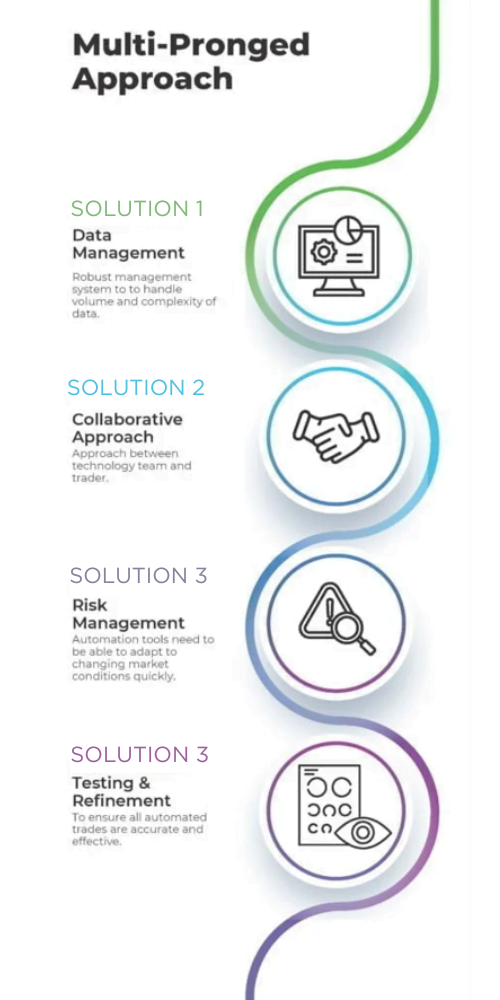Last week 20 of our buy side equity members came together at one of our digital cafes to share their advice, challenges and experiences on how they are approaching small and mid-cap trade automation. Small and mid-cap trades are often seen as highly manual and difficult to execute trades with automation being touted as a solution to these challenges. But is it a reality for most firms, or is it just fiction?
Approaches to Small and Mid-Cap Trade Automation
One approach to small and mid-cap trade automation is through the use of algorithms. Algorithms can help identify potential trades and execute them quickly, reducing the risk of slippage and market impact. This approach can be effective for firms that have a significant amount of data and are looking for a systematic approach to trading.
Another approach is to outsource the trade execution to a third-party provider. This can be a viable solution for firms that lack the expertise or resources to manage trades in-house. Outsourcing can also provide access to specialized trading strategies and technology, which can be difficult to develop in-house.
In addition, firms can also leverage the use of machine learning and artificial intelligence (AI) to automate trading decisions. By training algorithms on historical market data and market conditions, machine learning and AI systems can make predictions and generate insights that can inform trading decisions.

Challenges Associated with Small and Mid-Cap Trade Automation
One of the main challenges associated with small and mid-cap trade automation is the lack of liquidity in these markets. Liquidity is essential for effective trade execution, and low liquidity can lead to price impact and higher trading costs. To address this challenge, firms may need to develop specialized trading strategies that can take advantage of market conditions.
Another challenge is the complexity of the trading process. Small and mid-cap trades can involve multiple markets and require a deep understanding of the underlying assets. This complexity can make it difficult to develop effective trading strategies and algorithms.
There are several challenges associated with small and mid-cap trade automation. One of the primary challenges is that the process requires significant investment in technology and infrastructure. The cost of implementing an automated trading system can be significant, and many firms may not have the resources or expertise to undertake such an initiative.
Another significant challenge is the potential for errors and glitches in the automation process. Automated systems can be prone to errors, and even small mistakes can have significant consequences. Additionally, automated systems may not always be able to account for unexpected events or market conditions and may require manual intervention to prevent losses.
Additionally, there is a risk that automated trading may lead to a loss of human expertise and intuition. Traders with experience in small and mid-cap markets may be able to identify opportunities and risks that automated systems may miss. It is therefore important for firms to strike a balance between automation and human expertise.
Finally, regulatory and compliance requirements can also pose a challenge to small and mid-cap trade automation. Firms need to ensure that they are complying with relevant regulations and that their trading activities are transparent and auditable


Is Small and Mid-Cap Trade Automation a Reality for Most Firms?
Small and mid-cap trade automation is a reality for some firms, particularly those with significant resources and expertise. However, for many firms, it remains a challenge. Developing effective trading strategies and algorithms can be time-consuming and require specialized knowledge. Additionally, outsourcing can be expensive, and regulatory compliance can be a significant burden.
Suggested Solutions
To address the challenges associated with small and mid-cap trade automation, firms may need to take a multi-pronged approach. This could include investing in technology and data analytics to better understand market conditions and develop effective trading strategies. It may also involve partnering with third-party providers to access specialized technology and expertise. Finally, firms may need to ensure that they have a robust compliance and risk management framework in place to address regulatory requirements.
- Data management: One of the primary challenges in automating small and mid-cap trades is the vast amount of data involved. Firms should consider implementing a robust data management system that can handle the volume and complexity of data involved in these trades. This could involve utilizing machine learning algorithms to analyse and categorize data, as well as implementing data warehousing solutions to store and retrieve data efficiently.
- Collaborative approach: Automation requires a collaborative approach between the technology team and the traders. Firms should involve their traders in the development and testing of automation tools, as well as providing training and support for these tools. This approach can help ensure that the automation tools are tailored to the specific needs of the traders and are effective in streamlining their workflows.
- Risk management: Small and mid-cap trades can be highly volatile, and automation tools need to be able to adapt to changing market conditions quickly. Firms should implement robust risk management protocols that can identify and mitigate potential risks associated with automated trades. This could involve monitoring for anomalies or unusual patterns in trading data and implementing automated risk controls to prevent losses.
- Testing and refinement: Automation tools are not perfect and require ongoing testing and refinement. Firms should implement a process for testing and validating automated trades to ensure that they are accurate and effective. This could involve using historical trading data to test the automation tools or conducting simulations to assess their performance under different market conditions.
Small and mid-cap trade automation is a complex and challenging area for buy-side firms. While there are approaches to address these challenges, including the use of algorithms and outsourcing to third-party providers, these solutions are not without their own challenges. Ultimately, each firm will need to evaluate their own needs and resources to determine the best approach for managing small and mid-cap trades.

